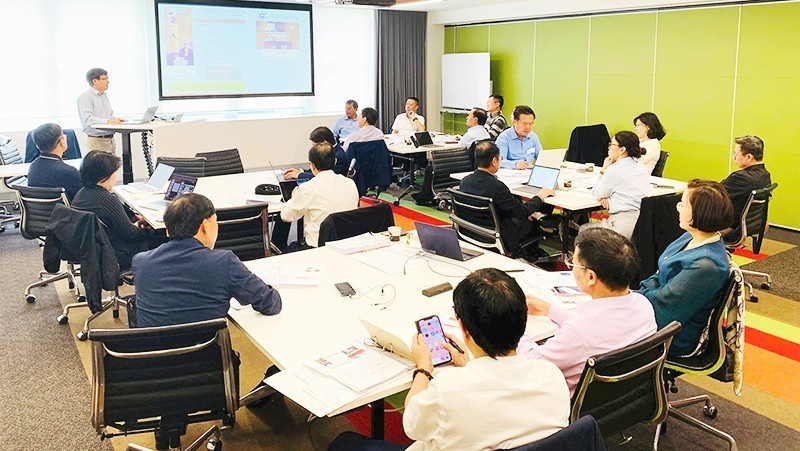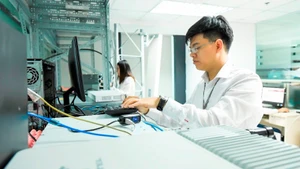With its ability to predict, recommend, automate and even generate new content, AI contributes to improving policy-making, risk monitoring, and public services, while also creating pressure for innovation in public governance. Experience from Australia — a leading country in responsible AI development — shows that this is an essential requirement for an effective public administration in the digital age.
AI deployed at multiple levels
In the short-term training course for officials from central ministries and localities of Viet Nam at the University of Technology Sydney (UTS), Professor Nabin Sharma, Lecturer at UTS, noted that AI can support humans throughout the entire cognitive process, from data collection and analysis to decision-making — a principle that has existed since the 1950s–1960s. However, today’s AI boom stems from two breakthrough shifts. First, AI has moved beyond automation to become systems capable of recommending, predicting, and even creating content, ranging from text and programming code to drafting policy. Second, AI is no longer external to decision-making processes but has become a participating entity in the system, capable of learning and continuously changing after deployment.
According to the Organisation for Economic Co-operation and Development (OECD), a modern AI system has three core capacities: providing suggestions and recommendations, generating content, and supporting decision-making. These capacities align with the operational characteristics of public governance, which must handle large volumes of data, detect trends early, and respond quickly to emergencies. In Australia, many public agencies have adopted data analytics and data-exchange platforms in healthcare, firefighting, disaster response, and urban management.
AI can be deployed at various levels, from fully human-led decisions to systems in which AI automates most processes and humans intervene only when necessary. At any level, UTS lecturers emphasised the consistent view that AI is created to serve humans, not to replace them. Research indicates that AI results in three main outcomes: increased productivity and operational efficiency of the administrative system, improved decision-making quality, and accelerated innovation that generates new value for society. However, Professor Nabin Sharma cautions that government agencies must clearly identify which decisions should be automated and which must remain under human control to ensure effectiveness, safety, and accountability.
One of the prerequisites for applying AI in public governance is ensuring sovereign data infrastructure. AI cannot be separated from data, while data itself contains sovereign characteristics and cultural identity of each country. Without sovereign data foundations and clear data-governance mechanisms, expanding AI applications may pose risks to national security, privacy, and data-flow control.
Australian experts highlight that the effectiveness of AI largely depends on data governance. Data sharing is essential for a modern state administration, where agencies handle information for citizens. However, traditional data sharing, whereby each agency must duplicate and store its own datasets, easily leads to duplication, security vulnerabilities, and resource waste. To address this, many Australian agencies have shifted to direct data-exchange models instead of intermediary storage, while classifying data by security level and applying encryption or anonymisation before sharing. In emergencies such as natural disasters, forest fires, terrorism, or major events, agencies including police, fire services, healthcare providers, and volunteer forces can temporarily connect to share real-time data, after which the system automatically disconnects to ensure safety.
The “Data Satellite” model — a government-level data-monitoring system — is likened to satellites observing data flows, tracking how data is created, circulated, and used to detect anomalies and risks in time. Data satellites may be deployed sector-wise in finance, healthcare, and education to ensure that critical data remains under state control.

Viet Nam needs a flexible AI governance framework
In Viet Nam, AI applications in public governance are growing swiftly. The national digital-transformation platforms, with large databases, electronic identity systems and online public services, have enabled ministries and sectors to begin piloting AI in analysing population data, education, healthcare, public investment, and anti-corruption efforts.
However, according to the AI maturity model of the Massachusetts Institute of Technology (MIT), one of the world’s leading institutions in science and technology, many agencies remain in the pilot and early-capacity-building stages. This creates an urgent need for standardised procedures, interconnected data sharing, and data-skills training so that AI can genuinely participate in administrative operations.
In response to Viet Nam’s context and the issues raised by Australian experts, Huynh Thanh Dat, Member of the Party Central Committee (PCC) and Deputy Head of the PCC’s Commission for Communication, Education and Mass Mobilisation, stated that effective AI application in social management and oversight not only requires technology but also monitoring tools that ensure transparency and accountability. He warned that the greatest current risk stems from using AI to generate content. “Without clear regulations, AI can be exploited for distortion, plagiarism, copyright violations, and erosion of public trust.” According to him, AI brings real benefits only when operated within a safe, controlled framework with ethical standards at its core.
From a social-science research perspective, Nguyen Bui Nam, Deputy Chief of Office of the Viet Nam Academy of Social Sciences, noted that if AI is introduced into public governance without clarifying how data is collected and how models operate, public trust will be affected. He emphasised that “AI models must be designed and operated transparently, with clear explanations of how they work, their algorithms, and training datasets in an open manner so that users and stakeholders understand how AI makes decisions, thereby enhancing trust and oversight.”
He added that periodic assessments are needed to detect and eliminate biases in data and algorithms, ensuring fair outcomes for all groups. Additionally, the privacy of research participants and personal data must be strictly protected, in compliance with laws and embedded into AI design from the outset. This includes limiting unnecessary data collection and strengthening anonymisation and encryption to minimise the risk of breaches.
He also stressed the need to clearly define responsibilities among parties involved in AI development and operation, with monitoring mechanisms and procedures for handling problems when they arise.
Emphasising the need for AI-governance policy, Professor Tran The Truyen, Head of the Department of AI, Health and Science at Deakin University, noted that Viet Nam must develop an appropriate legal framework to allocate resources, support workers in adapting to the new context, and control risks. He stated that Viet Nam has referred to many international governance frameworks “from US and European standards to ISO frameworks and the experiences of Singapore and Luxembourg — all leading countries. These governance frameworks form widely recognised practice standards.”
According to Professor Tran The Truyen, Viet Nam’s draft AI Law incorporates key principles such as a human-centred approach, risk mitigation, transparency, and creating a legal foundation for innovation, but greater consideration is needed for flexibility. As technology changes rapidly, laws must have self-adjusting mechanisms. Some technical details remain specific, which is beneficial for governance, but if they are too specific, they quickly become outdated.
He also noted that legislation should not place the entire burden on the State but must create enabling conditions for private enterprises, as they have faster innovation capacity.
In the context of a rapidly accelerating global AI race, “the window of opportunity” for Viet Nam is narrowing. Policies cannot wait five to ten years for adjustment, as everything will have changed by then. Viet Nam needs an environment that is both stable and flexible to keep pace with this speed of development.
















